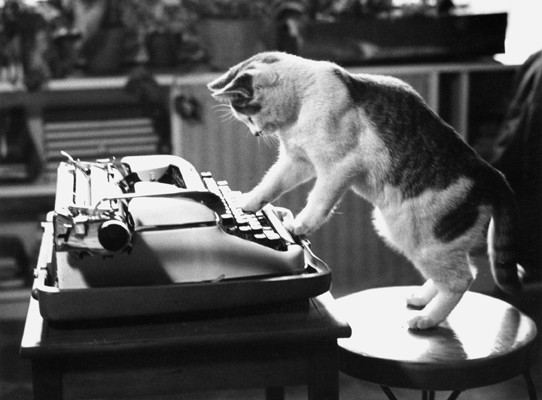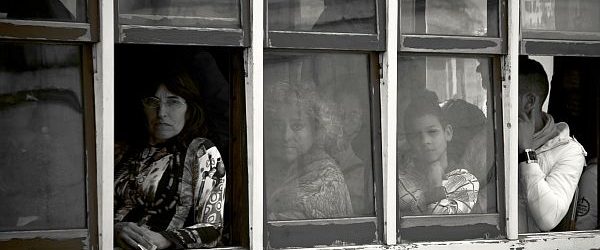1. Behemoth
 Behemoth, a character in Mikhlail Bulgakov’s masterpiece The Master and Margarita, is indisputably the top cat of literature. ‘A cat the size of a pig, black as soot and with luxuriant cavalry officer’s whiskers’, he appears in Moscow with his master, the Satanic Woland.
Behemoth, a character in Mikhlail Bulgakov’s masterpiece The Master and Margarita, is indisputably the top cat of literature. ‘A cat the size of a pig, black as soot and with luxuriant cavalry officer’s whiskers’, he appears in Moscow with his master, the Satanic Woland.
Woland and his entourage proceed to wreak havoc on Moscow’s intelligentsia and social elite. In one of my favourite scenes, Behemoth goes to the luxuriously appointed Writer’s Club with his demonic companion Koroviev. They have a short dispute with the door bitch, who demands their membership card:
‘But look here – if you wanted to make sure that Dostoevsky was a writer, would you really ask for his membership card? … I don’t suppose he ever had a membership card, anyway! What do you think?’ said Koroviev, turning to the cat.
‘I’ll bet he never had one,’ replied the cat, putting the Primus on the table and wiping the sweat from its brow with its paw.
‘Dostoevsky’s dead!’ said the woman, although not very certainly.
‘I protest!’ said Behemoth warmly. ‘Dostoevsky is immortal!’
Naturally they weasel their way in and the club burns down after a series of unfortunate accidents. Behemoth escapes with a whole salmon and his primus stove. How can you resist a cat who is unashamedly evil and smokes a cigar?
2. The Cat in the Hat
 One of Dr Seuss’s greatest inventions is another cat who causes mayhem, but with less grotesquerie and philosophy, when he invades the house of two glum children, whose mother (perhaps a career woman) is out of the house for the day.
One of Dr Seuss’s greatest inventions is another cat who causes mayhem, but with less grotesquerie and philosophy, when he invades the house of two glum children, whose mother (perhaps a career woman) is out of the house for the day.
‘I know some good games we could play,’
said the cat.
‘I know some new tricks,’
said the cat in the hat.
‘A lot of good tricks.
I will show them to you.
Your mother will not mind at all if I do.’
Obviously this isn’t going to turn out well. But this is a cat that, unlike every other cat I’ve met, tidies up after himself.
Also, clearly, a dreadful warning to mothers who don’t stay home all day.
3. The Cheshire Cat
 Lewis Carroll’s Cheshire Cat in Alice in Wonderland continues the theme of a certain sinisterness (is a pattern emerging here?) or, at least, an ambiguous nature. The cat ‘looks good-natured,’ as Alice thinks when she first encounters it. But it has ‘very long claws and a great many teeth, so she felt that it ought to be treated with respect.’
Lewis Carroll’s Cheshire Cat in Alice in Wonderland continues the theme of a certain sinisterness (is a pattern emerging here?) or, at least, an ambiguous nature. The cat ‘looks good-natured,’ as Alice thinks when she first encounters it. But it has ‘very long claws and a great many teeth, so she felt that it ought to be treated with respect.’
It’s notable mostly for its ever-widening grin and for the way it continually vanishes and reappears, which cat owners will recognise as very feline behaviour. It grins, the Duchess tells Alice, because it’s a Cheshire Cat, and all cats grin anyway. (Probably when we’re not looking.) Certainly, like most characters in this book, the cat is not helpful when Alice tries to speak to it, but the cat has a certain unnerving courtesy:
‘I wish you wouldn’t keep appearing and vanishing so suddenly: you make one quite giddy.’
‘All right,’ said the Cat; and this time it vanished quite slowly, beginning with the end of the tail, and ending with the grin, which remained some time after the rest of it had gone.
4. Cat
 Natsume Sōseki’s nameless cat is the narrator of his three-volume novel I Am a Cat. He’s a sardonic observer of Japanese middle-class life at the turn of the nineteenth century, and is perhaps a literary forerunner of the cats in Haruki Murakami’s novels. He is well-educated – he arrives as an orphaned cat in the home of an English teacher, with whom he lives all his life – but he remains, for all his narrative skills, distinctly an animal.
Natsume Sōseki’s nameless cat is the narrator of his three-volume novel I Am a Cat. He’s a sardonic observer of Japanese middle-class life at the turn of the nineteenth century, and is perhaps a literary forerunner of the cats in Haruki Murakami’s novels. He is well-educated – he arrives as an orphaned cat in the home of an English teacher, with whom he lives all his life – but he remains, for all his narrative skills, distinctly an animal.
The book is discursive a manner akin to Laurence Sterne’s Tristram Shandy, and is quite likely modelled on it: Sōseki, who was educated in England, uses his conceit to satirise the westernisation of modern Japan. The cat records abstruse conversations between intellectuals discussing absurd or grotesque concepts, interspersed with observations from the cat-level view. A typical passage concerns the cat’s offence at his master’s lack of respect:
If he is taking my miaows for granted, indeed he presumes too far. Such failure to respect another person’s personality, a deadly insult to any cat, is the sort of crude insensitivity which one must expect from creatures like my master’s own particular pet aversion, the nauseous Mr Goldfield. But the same behaviour on the part of my master, a man so confident of his open-heartedness that he struts about stark-naked, can only be seen as an act of unwonted weakness.
I think we all suspect that cats are judging us. We can only be glad they don’t write books.
5. Jeoffrey
 Jeoffrey, as described by the poet Christopher Smart in his poem Jubilate Agnato, might be the most charming cat in all literature, and is certainly one of the least anthropomorphised. Smart simply describes, with a poet’s joyousness, his cat’s behaviour.
Jeoffrey, as described by the poet Christopher Smart in his poem Jubilate Agnato, might be the most charming cat in all literature, and is certainly one of the least anthropomorphised. Smart simply describes, with a poet’s joyousness, his cat’s behaviour.
For I will consider my Cat Jeoffry.
For he is the servant of the Living God, duly and daily serving him.
For at the first glance of the glory of God in the East he worships in his way.
For is this done by wreathing his body seven times round with elegant quickness.
For then he leaps up to catch the musk, which is the blessing of God upon his prayer.
For he rolls upon prank to work it in.
For having done duty and received blessing he begins to consider himself.
For this he performs in ten degrees.
For first he looks upon his forepaws to see if they are clean.
For secondly he kicks up behind to clear away there.
For thirdly he works it upon stretch with the forepaws extended.
For fourthly he sharpens his paws by wood.
For fifthly he washes himself.
For sixthly he rolls upon wash.
For seventhly he fleas himself, that he may not be interrupted upon the beat.
For eighthly he rubs himself against a post.
For ninthly he looks up for his instructions.
For tenthly he goes in quest of food.
For having considered God and himself he will consider his neighbor.
For if he meets another cat he will kiss her in kindness.
For when he takes his prey he plays with it to give it a chance.
For one mouse in seven escapes by his dallying.
For when his day’s work is done his business more properly begins.
For he keeps the Lord’s watch in the night against the adversary.
For he counteracts the powers of darkness by his electrical skin and glaring eyes.
For he counteracts the Devil, who is death, by brisking about the life.
‘Brisking about the life’. Yes!






